To manage a team well, you need certain principles and skills….
Managing a Growth Team involves additional complexities, which is why I’m going to show you:
- What Team Management is
- What a Growth Team is
- How to start and scale a Growth Team
Let’s get started…
What is Team Management?
Team Management is the ability of a leader to organize and coordinate a team to accomplish tasks that lead them to a common goal.
Leaders who have skills and know how in team management are able to motivate, support and connect the team.
What is a Growth Team?
Brian Balfour put it well:
“A growth team is a small, diverse, focused, data-driven group of unique individuals who continually push themselves to learn and implement new growth strategies, tactics and techniques. The growth team blends people with engineering, design, product and marketing backgrounds into one cohesive unit to work in rapid iterative experiment cycles aimed at increasing the growth rate.”
Leaders who have skills and know how in team management are able to motivate, support and connect the team.
There are 4 types of company cultures:

- Family culture: very friendly work environment where people have a lot in common. Managers are considered mentors and sometimes even father figures, commitment among employees is high here. Emphasis of the organization is on personal development of employees and teamwork.
- Adhocracy culture: a dynamic, entrepreneurial and creative work environment where employees stick their necks out and take risks. Executives are innovators who hold the organization together with collaborative experimentation and innovation. Focus of this organization is in tapping new revenue streams from new products or services.
- Hierarchical culture: there is a formalized and structured work environment. Actions of employees are determined by procedures where managers are expected to act in an efficient and coordinated manner. Organization is focused on maintaining a smoothly running process.
- Market culture: greatest concern is about meeting targets where employees are competitive and goal-oriented. Managers are tough and demanding, organization is held together by a common drive for success. Focus of the organization is on achieving measurable goals.
Why Team Management?
Good team management provides many benefits:
- Increases productivity
- Reduces burn-out
- Creates synergy in the team
- More effective communication
- Increases job satisfaction
- Reduces staff turnover
- Reduces problems in the team
- Creates clear expectations
Why a Growth Team?
Harvard Business Review examined why it is important to integrate a Growth Team into your business:
- Define and achieve the company’s growth priorities: manage customer acquisition, reduce customer churn, execute the vision and optimize the company for revenue growth.
- Set up data management: to properly analyze experiments, a strong data structure is needed.
Growth Teams are strong at finding customer insights, why customers leave, why there is less traction or why the product is not bought. The answers they find will then help the product team prioritize the backlog.
How do you start and scale a Growth Team?
Building a team has 5 phases:
- Forming: the orientation phase where members align desires and expectations and where goals and methods of operation are determined.
- Storming: the power and influence phase where the distribution of power and influence is explored where opinions and views are shared.
- Norming: the establishment of agreements and rules through which people assume their positions and the way of working takes shape, in this phase the team spirit is developed.
- Performing: here the focus is on effectiveness and production, team members become team players. The focus is more on results than on the team, autonomy develops.
- Adjourning: when saying goodbye to the team the focus is on aftercare, not all teams enter this phase.
How to start a growth team:
- Check what phase your company is in
Before you start a growth team, you should check what stage your company is in and whether you have product-market fit.
- Formulate objectives and principles
Start by formulating the objectives for your team and the principles according to which they should work.
- Hire a Head of Growth
Get someone to sit in the middle of marketing, sales and product development.
- Increase growth maturity with processes
Climb up the Growth Maturity model to make sure your team is mature enough for the next step.
- Appoint the right people
At the very least, a team consists of a hacker, hustler, hipster and handler. If your team and company are mature enough you can build your team further.
1. Check what stage your company is in
Before you start a Growth Team, you need to know what stage your business is in:

You don’t want to start a Growth Team until you have product-market fit and can start growing your business based on a validated product:

2. Formulate goals and principles
Start by formulating an objective using the North Star Metric, this allows teams to have simpler meetings, less documentation, and have all teams focus on one common goal:
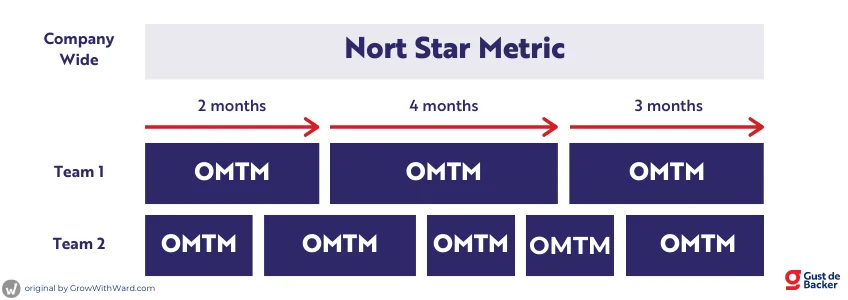
In addition, you can set up short-term goals using the One Metric That Matters:
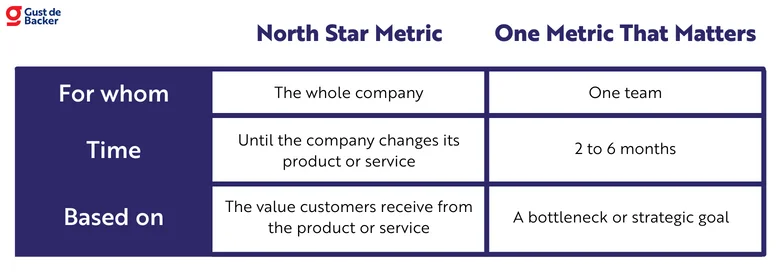
To map out a somewhat more long-term strategy, it is helpful to create an OGSM model or follow the OKR framework.
Formulate your principles
You don’t want to be constantly looking for new tactics, but build in principles and processes:
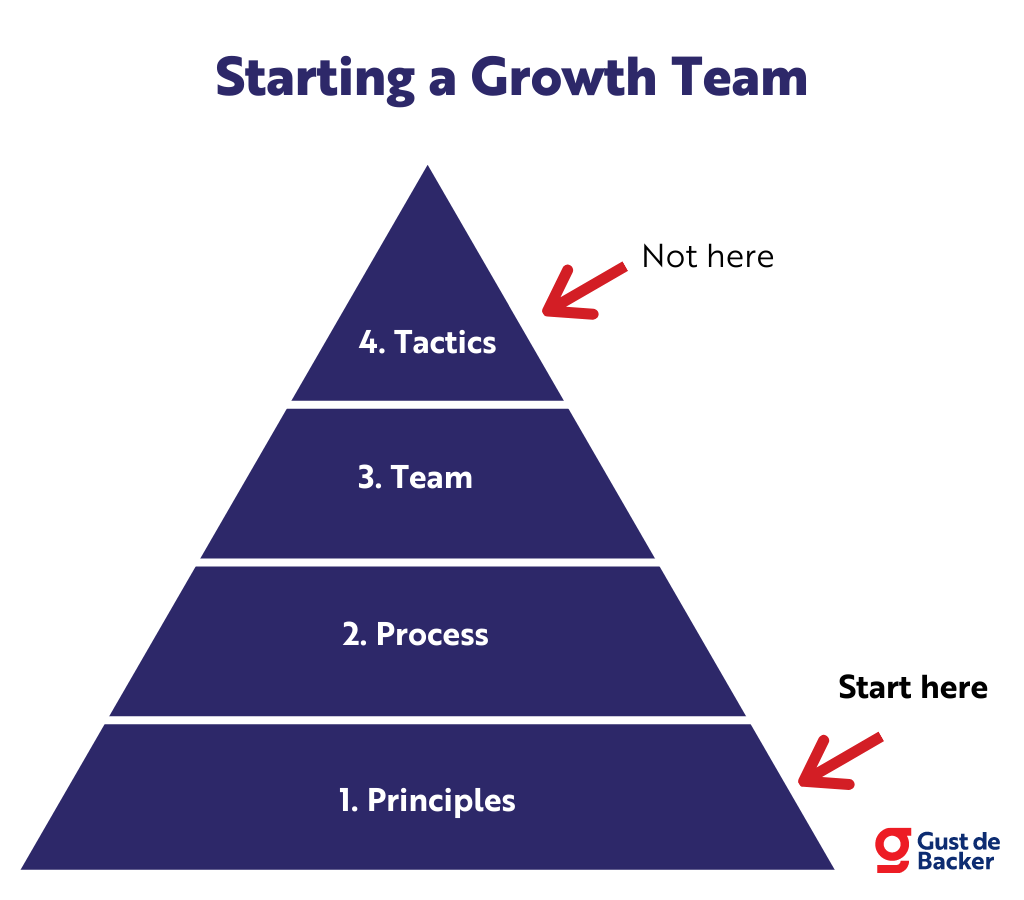
Establish principles that set the tone for everything you will do; they are your team’s core values. These principles will begin to guide your team through difficult decisions. Brian Balfour states that there are 4 principles that successful growth teams follow:
- Maximize learning: in every industry there are internal and external changes that you will have to adapt to. The only thing we can control is how much we learn and how quickly we can apply it. Maximize the learnings about:
- Customers/users: what motivates our users? What are they spending time on? How big is the problem we are solving?
- Product: how is our product used? How do customers get to our product? How effective is our product in solving the problem?
- Channels: how do our channels work? How can we find an algorithm to “hack” channels?
- Focus on impact: if everyone is responsible then no one is responsible, make sure there is the right focus in the team. Focus on the following aspects:
- Focus your team on opportunities, not ideas. Identify in which areas the biggest opportunities lie instead of coming up with ideas for small problems every time. Ask yourself, how do you identify areas where impact can be made?
- Continue to challenge the “why” behind tasks, why are certain things being picked up now when other things are left to be done. Ask yourself, how do you choose which tactics to test?
- Don’t immediately assume that what’s there now or how the positioning is now that that’s the right way. Challenge the DNA of your marketing. Ask yourself, how do you hire the right people for your growth team?
- Give Growth Teams enough responsibility and authority to be able to make an impact, because other teams may feel like they are responsible for a certain part in the funnel. Ask yourself, how do you make sure your growth team gets what they need?
- Reward impact rather than activity, this can be done, for example, by talking weekly about which experiments have made an impact or celebrating the percentage growth week on week. Ask yourself, how do you measure, reward and celebrate success?
- Balance art and science: creativity and measurable results are both hugely important. It’s not a matter of one or the other, but insights can come from 3 sources:
- Quantitative: use data to determine where you currently stand, how much improvement you want to make, and the impact of that improvement.
- Qualitative: based on observations in the quantitative data you can start collecting qualitative data by, for example, talking to (potential) customers.
- Intuitive: using intuition it is possible to think of possible solutions.
- Embrace change: change is the only constant we have, adapt or become irrelevant. There are 4 reasons why this principle is important:
- Product evolution: the product must deliver more value to the end user with each iteration. How has the product evolved over time?
- Audience shift: the target audience will continue to change continuously. Who is the target group and how has it changed over time?
- Channels change constantly: channels keep changing, companies that adapt quickly can realize enormous growth. Which channels do we use and how have they changed over time?
- Tactic fatigue: the effectiveness of tactics is stagnating at a rapid pace. When something is new it works well, but after a certain time the effect will hardly be visible.
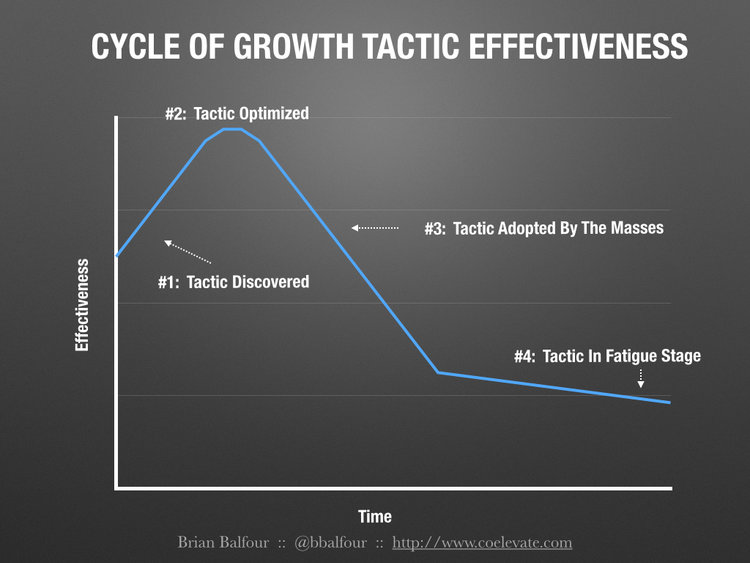
It’s important to build a culture of experimentation and not put all your money on one horse. Is your company already experimenting?
3. Hire a Head of Growth
A Head of Growth sits in the middle of marketing, sales and product development. It is their responsibility to optimize the whole Pirate Funnel.
Make sure you are clear on how you see the Head of Growth role and do not expect everything from one person, because it is almost impossible for one person to be an expert on everything.
Daphne Tideman researched several Head of Growth positions and found that the following is expected:
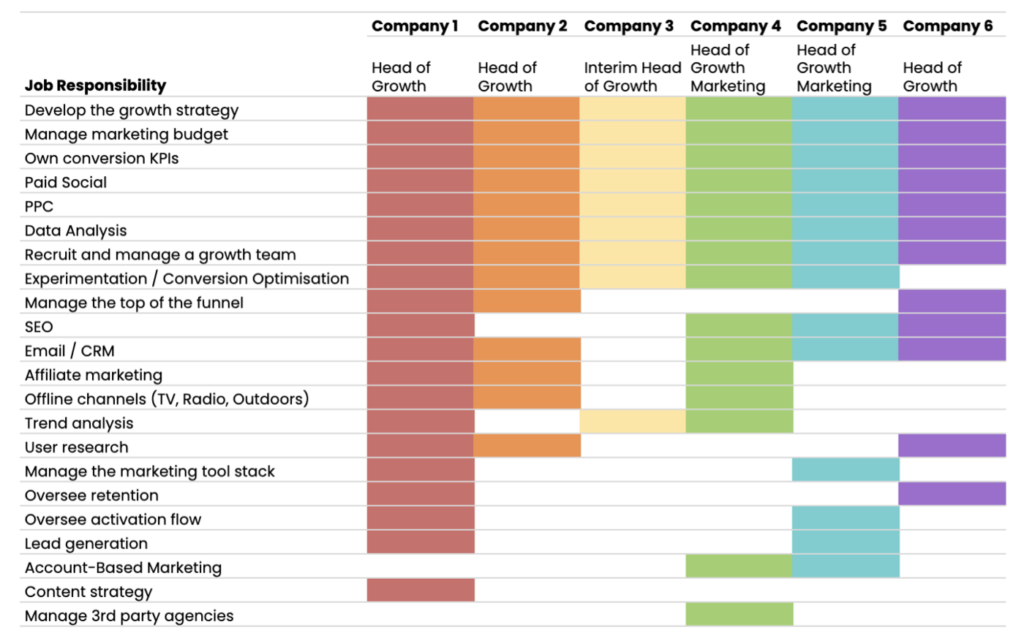
In which the following characteristics are sought:
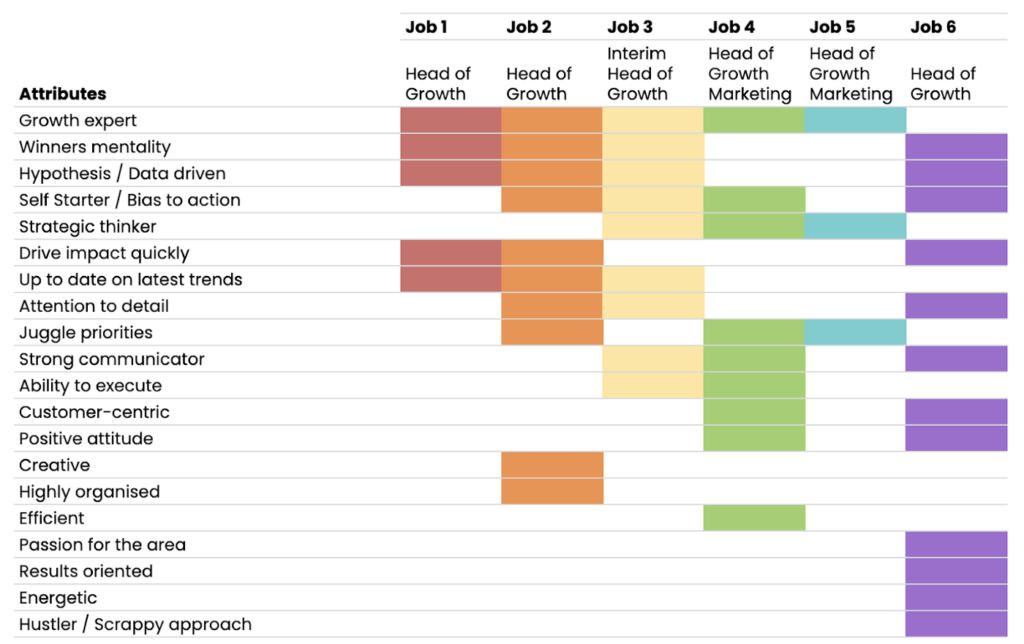
In which she has personally experienced in practice that a Head of Growth role is ultimately responsible for:
- Good qualitative and quantitative analysis skills: seeing patterns and trends in data.
- Ability to set up and improve a Growth Strategy: good insight into which growth drivers will make the difference.
- Growth Mindset: not afraid to fail and extremely driven to learn.
- Experiment-based approach: set up hypotheses and test them experimentally for maximum learning.
- Hire and manage a Growth Team.
“Hire someone who can do 50% of what you need, and can figure out the other 90%”.
Matt Lerner
4. Build processes to increase Growth Maturity
Ward van Gasteren created the Growth Maturity Model, which allows you to evaluate how mature your company is with growth.
Increasing Growth Maturity and building processes that ultimately allow your team to scale faster doesn’t happen overnight….
There are a few things that will work well for any team:
- Following an Agile framework, which uses:
- Backlog / Sprint planning: a meeting to fill the backlog and prioritize tasks.
- Sprints: period of 1-4 weeks in which the backlog is executed to deliver a new iteration.
- Sprint review: reviewing the results of the past sprint and incorporating 1 to 3 improvement actions for the next sprint.
- Definition of Done: within software development, it is important to agree on a definition of done that includes testing, documentation and reviews by others.
- Weekly/Sprint Retrospective: looking back at the collaboration and the process to identify what can be improved. It may also be interesting to periodically hold a team stop together with a manager.
- SCRUM Master: the SCRUM master is responsible for process improvement, this person looks critically at the entire process to find and resolve bottlenecks.
- Daily stand-up: grab 15 minutes daily with the team to look at what each individual did yesterday, what each individual will do today and what they may need help with.
- Playbooks / Standard Operation Procedures (SOPs): a playbook or SOP is a manual for common tasks, this ensures that the team can do repetitive tasks efficiently and that new people spend less time learning a way of working. Some examples of what a playbook could be made for:
- Website migration.
- SEO check.
- SEA optimizations.
- E-learning for new employees.
- Analyzing an experiment.
- Setting up an experiment.
- Prioritizing experiments.
5. Appoint the right people
A Minimum Viable Team consists of 4 types of people:
- Hacker: developers & (data) engineers, builds the prototypes and solutions.
- Hustler: marketing & business, basically a growth hacker who scales up customer acquisition and distribution.
- Hipster: design & user experience, improves the UX so people convert better.
- Handler (Head of Growth): manager who keeps the team focused on the right things and makes sure the team gets what they need.
It depends on the size of your company whether you want to hire new people for this or appoint motivated people within your company part-time to the Growth Team to get traction.
In doing so, it is important that you appoint people who have a Growth Mindset and not a Fixed Mindset:
| Growth Mindset | Fixed Mindset |
| Embraces challenge | Avoids challenge |
| Wants to learn continuously and seeks feedback | Gives up quickly |
| To become excellent, one must make an effort | Find effort unnecessary |
| Learns from criticism and feedback | Avoid or ignore feedback |
| Find insights and inspiration from the success of others | Feels threatened by the success of others |
Belbin’s nine team roles, with each person naturally fitting well into two to three primary roles:
- The President: brings people together, gathers opinions and drives a decision.
- Strengths: communicatively strong, goal-oriented, decisive and good at delegating.
- Pitfalls: takes decisions too quickly, pushes ahead, shifts responsibility and has little personal input.
- Suitable function: chairman, project leader or team spokesperson.
- The Shaper: expresses wishes and opinions, dares to go against opinions, gives direction, generates action and takes decisions.
- Strengths: result-oriented, proactive, dares to take action.
- Pitfalls: can be provocative and come across as pushy or authoritarian.
- Suitable function: project leader/director.
- The Plant: creative, original and comes up with new ideas off the beaten path with high imagination.
- Strengths: creative.
- Pitfalls: can get absorbed in own ideas, close himself off and what is conceived is not always practical.
- Appropriate role: consultant, designs, researcher or writer.
- The Monitor: analyzes problems and views ideas critically. Remains objective where position is supported with clear arguments for an informed decision.
- Strengths: critical thinking, objectivity and judgment.
- Pitfalls: can be aloof, has difficulty coming to a decision and continues to argue.
- Appropriate position: advisor, negotiator, planner, secretary or researcher.
- The Businessman: disciplined, systematic, and converts decisions into feasible and realistic work.
- Strengths: discipline, self-control, efficient and reliable.
- Pitfalls: not flexible, tends not to be open to other ideas and gets stressed if there is no good plan.
- Suitable job: planner, organizer, secretary or management tasks.
- The Source Investigator: always looking for ideas, developments and information.
- Strengths: energetic, inquisitive, creative, curious and innovative.
- Pitfalls: indecisive, overenthusiastic, quickly loses interest and therefore does not finish everything.
- Appropriate function: team spokesperson, inspiration or researcher.
- The Group Worker: focused on cooperation and fostering team spirit while supporting others.
- Strengths: strong conversation skills, helpful, loyal and flexible.
- Pitfalls: sometimes indecisive, avoiding confrontation.
- Suitable function: coach, atmosphere keeper, mediator or chairman.
- The Specialist: deals mainly with the content and provides the right knowledge and information.
- Strengths: purposeful, solution-oriented, independent and persevering.
- Pitfalls: focuses too much on details and has little interest in working together.
- Appropriate position: researcher.
- The Caretaker: makes sure everything is prepared and keeps an eye on the plan.
- Strengths: meticulous, keeps track of deadlines and is conscientious.
- Pitfalls: impatient, doesn’t like to delegate and gets nitpicky about details.
- Appropriate function: planner, secretary or editor.
Growth Team Models
You are free to choose how you will structure your Growth Team(s), but there are a few models that Andrew Chen says describe how to integrate it into your organization:
- Independent Model (by flow/feature): the team is separated from other departments. In this, the creative on the Growth Team does not have to answer to the Head of Marketing. In this example, teams are divided based on flow or feature:
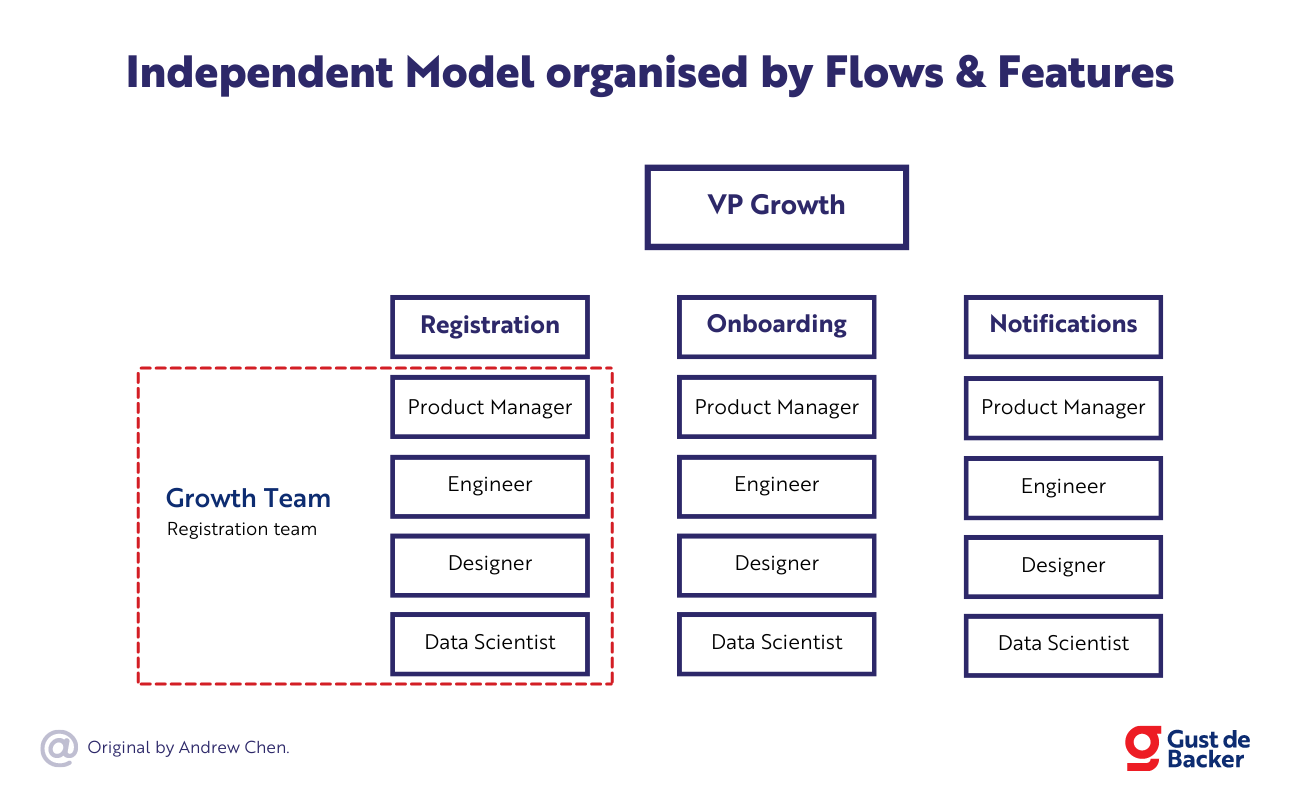
- Independent Model (by metrics): this model is used slightly more often than the Independent Model by flow/feature, it is organized based on metrics c.q. components of the Pirate Funnel:
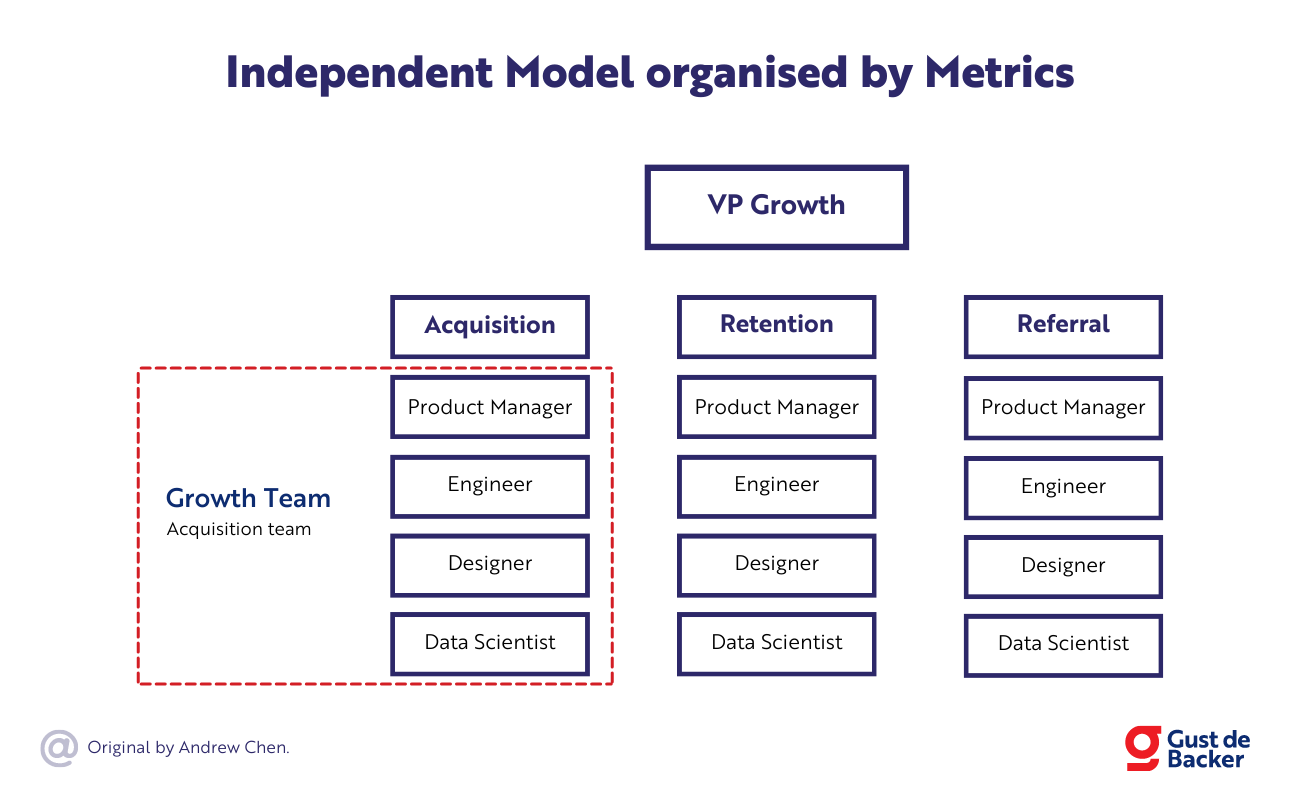
- Functional Model: this is also a common model where individuals from other departments are involved in the Growth Team. The advantage of this is that there is a lot of structure and Growth Teams get more done because there is more support from across the organization:
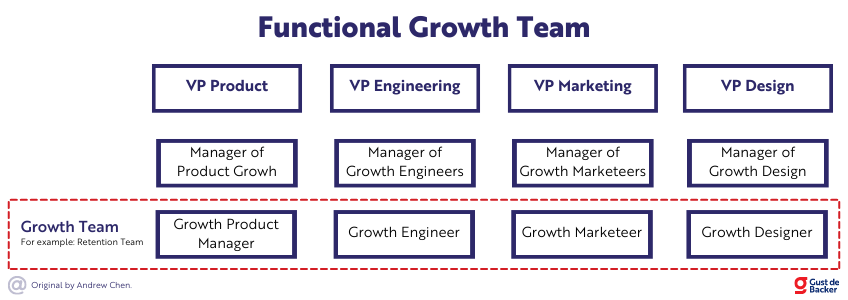
- Mixed Model: hybrid model where, for example, the Growth Engineer is on the Growth Team and the marketer + designer are drawn from other teams:
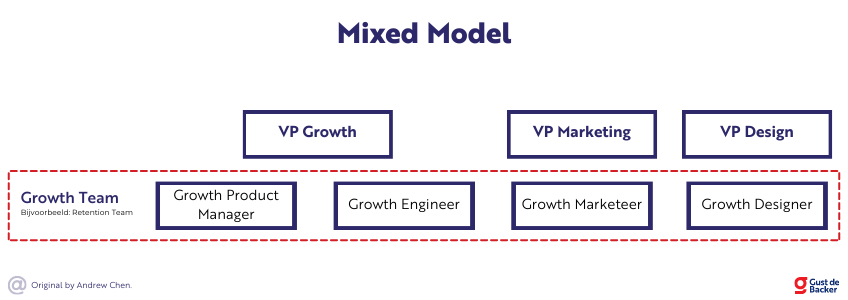
In addition, it is also good to take a critical look at the use of the Growth Team:
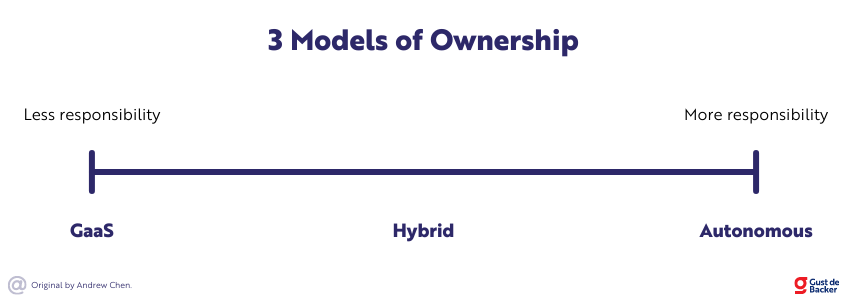
- GaaS: the team has hardly any responsibility and jumps in when help is needed somewhere in terms of analysis and/or optimization. In this case, the Growth Team is a guest of another team and cannot make major commitments.
- Autonomous: the Growth Team is the owner of the entire funnel, in this form it needs sufficient capacity and management.
- Hybrid: the mix between GaaS and Autonomous.
| Pros | Cons | |
| GaaS | Rapid growth in multiple parts of the business at once | Teams have different priorities, growth can’t find its own way |
| Hybrid | Best of both worlds | Difficult to draw lines in the sand |
| Autonomous | Growth can find its own way and make big changes | Larger team needed as time provides or innovations slows |
Check with your company what the ratio of the Growth Team is. At UBER, a ratio of 1:5 was used; for every 5 people hired, one had to go to the Growth Team.
How do you manage a (Growth) Team?
As a manager, it is important to know what drives each individual person on your team.
Have your team take a Myers-Briggs Type Indicator (MBTI) test to see what personality type they have.
With the personality types it’s possible to determine which people go well in a team:

Optionally, you could also use DISC to see what type of person you have sitting across from you:

In addition, it is important for a manager to:
- Communicate directly and transparently: a lot of employee stress can be reduced through direct and transparent communication.
- Have a clear vision: make sure everyone in the team is aware of the objective(s) and that everyone is working towards the same thing.
- Encourage teamwork: individuals are 2.3 times more engaged in their work if they feel part of a team.
- Delegate with care: a manager should give employees tasks based on their skills, experience and competencies. In doing so, the manager must trust that the employee will complete these tasks completely and on time while ensuring that the workload is not too high.
- Provide feedback and recognition: constructive feedback sessions provide insight into areas where someone can improve and also give them a good idea of where they stand. Giving recognition gives an enormous boost to a team member’s morale and a lack of recognition can lead to burnout.
- Provide clarity in responsibilities and expectations: if you make everyone responsible, no one feels responsible and it is also good to make expectations clear, but make sure those expectations are not too high.
- Enable the team to get results: make sure you serve your team instead of managing them. Make sure they get everything they need to deliver the desired results.
- Be the last to talk: let your team talk before you raise issues yourself and don’t always assume that you are the one who is right.
Delegate
There are 12 types of people when it comes to not delegating:
- Perfectionists: “if you want it done right, you have to do it yourself.”
- Skeptics: “do you really think you know how to do it?”
- Fearful: “I won’t burn my fingers a second time.”
- Born despots: “I am paid to think, you are paid to work.”
- Control freaks: “wouldn’t you put that cup of coffee a little further away from your keyboard?”
- Einzelgängers: “let me just do it myself.”
- Procedure-lovers: “I know exactly how that works, so I’ll take care of it.”
- Indispensable: “I’m the only one who can do this task.”
- No time: “I don’t have time to train anyone.”
- Offside: “I don’t want to put myself offside.”
- Responsible: “I am responsible and held accountable.”
- Too much work: “my employees are already up to their ears in work.”
If your answer to any of the following questions is “Yes” then you can delegate it:
- Can the task be done by someone else?
- Would the task be better done by someone else?
- Can or should another person learn to do this?
- Does another person enjoy doing this?
There is a difference in wanting (being willing and motivated) and being able (being capable and competent).
11 promises of a manager
Matthew Rechs has compiled 11 promises that he keeps as a manager:
- We have a weekly 1:1. I will never cancel this meeting, but you can cancel it whenever you want. It’s your time.
- Our 1:1 agenda is in the meeting invite, which ensures that we keep remembering what are important topics. You are free to use the time however you want.
- When I schedule a meeting with you I will always say what it is for. I never schedule a meeting without an agenda.
- If I send you a DM I will always say why, without small talk making you wonder what I want from you.
- Important news that will have a big impact on you you will always hear from me in a 1:1, not during a big announcement.
- Feedback you will receive from me when it is fresh, so you don’t hear it for the first time during a performance review.
- I trust you with your time. You don’t have to discuss with me first when you are absent.
- You do your work the way you want to. My focus is on results, not output. Once we are clear on where we want to go it is up to you to figure out how we are going to get there. If I have an idea I will give you an example.
- A team is at its strongest when everyone is helping each other. Look left and right to find opportunities in which you can help colleagues. Ask for help when you need it.
- I trust you to talk to my manager or board if you think it’s relevant. You don’t have to agree with me, and I won’t go crazy if you do.
- I will give you and your team credit where you deserve it. I will never exaggerate my own role or tenderness. If senior management asks where attribution comes from I will nominate you or yours.
If the above sounds good to you, I only ask for one thing in return. The truth. Give feedback, say when we are doing it wrong and share ideas on how we can do it better.
Covey’s seven
Stephen Covey writes in “the seven traits of effective leadership” that leaders possess the following habits:
- Be proactive: be guided by your values and needs. Accept that you cannot influence everything, and in doing so, be proactive rather than reactive.
- Start with an end in mind: make the end goal as concrete as possible and focus on it. Be effective rather than efficient. Do the right things rather than things well.
- Important things first: tasks that contribute to the goal and are important enough you pick up, unimportant tasks you delete.
- Think in win-win: don’t compete, but work together. We often think things are scarce, but there is enough for all of us. Grant others the same as yourself.
- First understand and then be understood: are you really listening to what the other person has to say or are you already formulating your answer? Often we hear the bell ringing, but don’t know where the clapper is.
- Create synergy: in a team of synergy people complement each other, the whole is more than the sum of its parts.
- Keep the saw sharp: continuously take time to improve yourself mentally, physically, social-emotionally and spiritually.
Developing employees
There are 4 stages in developing an employee’s skills and how you help them do that:
- Lead: there is little support and a lot of direction. The leader tells what the goal is, what a good execution looks like and what steps are involved.
- Supervise: here there is a lot of support and guidance, but the responsibilities are already lightly divided. The employee has a little more say.
- Support: there is a lot of support and little direction. The leader supports the employee’s efforts, listens to suggestions and asks questions to build trust. Here the leader is already convinced of the competencies.
- Delegate: here responsibilities are transferred from the leader to the employee.
5 dysfunctions of a team
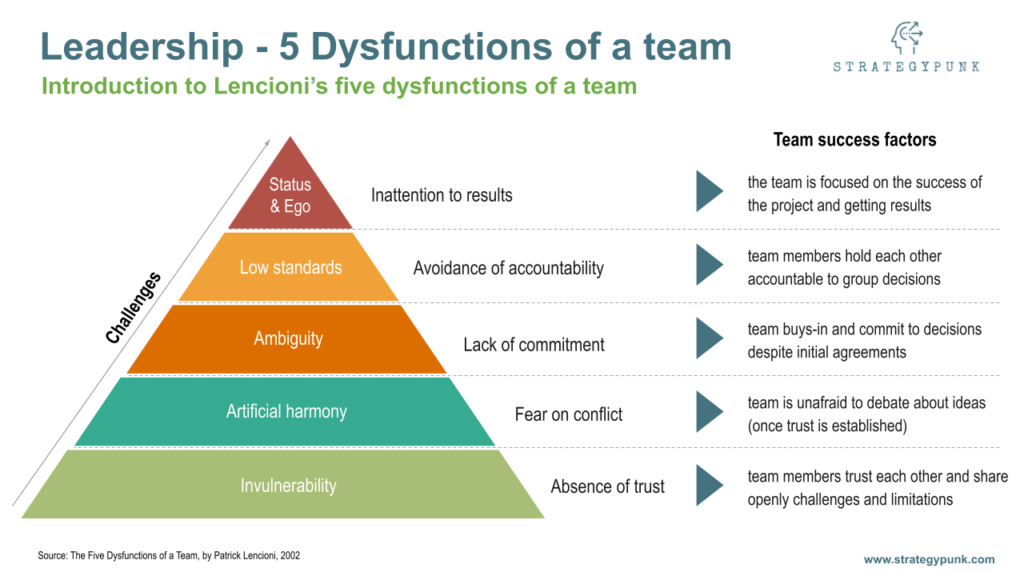
- Absense of Trust: if team members do not dare to show where their weaknesses lie, it will result in team members not being open with each other, not daring to say what mistakes they make and not daring to ask for help.
- Fear of Conflict: a lack of trust causes fear of conflict, which results in team members not contributing anything to a discussion or meeting.
- Lack of Commitment: fear of conflict results in team members who do not agree with decisions that are made, leading to ambiguity.
- Avoidance of Accountability: lack of commitment results in team members not holding each other accountable. If one person does not believe in a decision they will not hold their team members accountable.
- Inattention to Results: when team members don’t feel accountable they will put their own goals above those of the team resulting in a visionless team that will ultimately lead the company.
Now it’s your turn…
So… Now you can start your team or manage your current team better.
I’m curious, what do you think are the most important principles in a team?
Let me know in a comment…
P.S. if you would like additional help, please let me know at [email protected].
Frequently asked questions
Lack of trust that prevents people from being vulnerable, fear of conflict, lack of commitment, lack of responsibility and too little focus on business results.

![Business-Driven Marketing (BDM): 8 Steps to Drive Business Impact [+14 Templates]](https://gustdebacker.com/wp-content/uploads/2024/07/Business-Driven-Marketing-BDM.png)
![Automate ~30% of Repetitive Marketing Tasks with AI: 5 Easy Steps [+ 7 Expert Prompts]](https://gustdebacker.com/wp-content/uploads/2024/07/AI-in-Marketing.png)
![Customer Journey Map (2025): How-to & Examples [+ Template]](https://gustdebacker.com/wp-content/uploads/2023/11/Customer-Journey-Map.png)

I’ve read your insightful article on team management and found it highly valuable for anyone looking to build and lead effective growth teams.
Great to hear, Vishal!